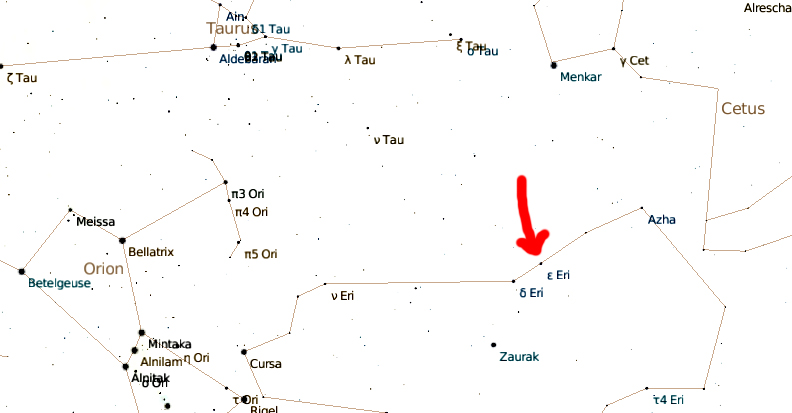Author Archive
 Carnival of Space #77 … or is #78?
Carnival of Space #77 … or is #78?
This week’s Carnival of Space is hosted by Tomorrow is Here – and Alice’s Astro Info is featured, so don’t miss it!
 November-December Sky
November-December Sky
A guide for what’s coming up this month. I tried to include a fact and a lesser-known story for each object. I didn’t completely succeed. This guide is written to give hints to people who already know approximately what they’re looking at. For a good beginner’s guide to the sky, try StarDate, Sky and Telescope’s Stargazing Basics, or Sky and Telescope’s links to lots of beginning topics. (Or, if you know a better beginning stargazing site, put a link to it in a comment below!
New Constellations
ORION – The Hunter
SCIENCE: Don’t miss M42 – The Orion Nebula. When looking at the constellation, it’s where Orion’s sword is hanging from his belt. It’s a star-forming nebula made of gas and dust.
MYTH:The Bororo Indians of Brazil see a fearsome caiman in the stars of Orion. The Black Caiman of the Amazon is one of the largest types of alligators, and one of the few that poses a danger to humans. Sadly for the Black Caiman, we pose more of a danger to it: it has become an endangered species due to human hunting of its skin.
TAURUS – The Bull
SCIENCE: We’ve got two open clusters in Taurus – The Pleiades (in his shoulder) and the Hyades (the “V” shaped head of the bull. Open clusters are a small collection of stars that are actually gravitationally bound to each other. They tend to be young, newly-formed stars that are slowly moving apart from each other.
I love to mention that the Pleiades are my favorite deep sky object in the night sky – because they look different every night. Depending on the weather and your eyes, you might see a smudge, 4 stars, 6 stars, or even 10. With binoculars you’ll see dozens of stars. With a telescope you’ll see hundreds. It’s a great gateway into astronomy.
MYTH: Taurus is Zeus – in the bull form he used to conquer Europa. A slightly more family-friendly version of the story has Orion fighting Taurus the bull – and the Pleiades are a wound where Orion has stabbed him.
GEMINI – The Twins
SCIENCE: Castor and Pollux are the “head” stars of the twins. Castor is a septuplet star – three pairs of stars orbiting a common center of gravity. Yii! Six!
MYTH: India also considers these stars twins, they are called Aswins, the twin horseman associated with the dawn.
PISCES – The Fish
SCIENCE: I find Pisces by starting with the circle at the top. It doubles as Pegasus’s wings, although it is officially part of Pisces.
MYTH: The only way I can make heads or tails of this constellation is to see it as two fish on an upside-down fishing line.
CETUS – The Sea Monster
SCIENCE: As it is far out of the plane of the Milky Way, it is easier to see other galaxies in this area of the sky with a good telescope, though none of them are naked-eye visible.
MYTH: Cetus is part of the giant Andromeda/Cassie/Perseus/Cepheus/Pegasus mythology.
AQUARIUS – The Water Bearer
SCIENCE: There are a few clusters and nebulae in Aquarius, but the one that I find most beautiful is the Helix nebula. It’s a planetary nebula – an exploded envelope of gas around a star that went supernova many, many years ago. Do not confuse it with the Ring Nebula – it looks similar, and is the same type of nebula.
MYTH: Aquarius is the Water-bearer. This is also the constellation referred to in the phrase “Age of Aquarius” – but that’s of astrological significance, which I can’t speak to.
“Tiny” Guys
Going for the Gold? Here’s this month’s itty-bittys.
SCUTUM – The Shield
CAMELOPARDALIS– The Giraffe
SCULPTOR – A Sculptor’s Studio
ERIDANUS – The River
RECENT SCIENCE: Epsilon Eridani (ε Eri, a star in Eridanus) is a Sun-like star, AND we’ve detected two debris belts (like our Asteroid Belt and Kuiper Belt) around it. Beyond that there are at least two planets there.
TRIVIA: ε Eri is a very popular location in science fiction. In this case, I recommend the Wikipedia article. Notably – Babylon 5 is located at ε Eri. I thought I had been told that Vulcan orbited ε Eri, but I can’t find official confirmation of that. Vulcan is supposedly 16 lightyears away – ε Eri is 10 lightyears away.
TRIANGULUM – The Triangle
ARIES – The Ram
LYNX – The Lynx
LACERTA – The Lizard
EQUULEUS – The Little Horse
SAGITTA – The Arrow
VULPECULA – The Fox
Returning Constellations
ANDROMEDA – Princess Andromeda
PEGASUS – The Winged Horse
CEPHEUS – King Cepheus
PERSEUS – Perseus
DELPHINUS – The Dolphin
AQUILA – The Eagle
CYGNUS – The Swan or the Northern Cross
LYRA – The Harp
URSA MAJOR – The Great Bear
URSA MINOR – The Little Bear
CASSIOPEIA – The Queen
Happy Sky Viewing!
Where’d I get my Info?
My memory, and Zeta Strickland
 Gender Analyzer
Gender Analyzer
Haha!! Gender Analyzer (http://www.genderanalyzer.com) thinks Alice’s Astro Info is written by a man:
Results
 We think http://alicesastroinfo.wordpress.com is written by a man.
We think http://alicesastroinfo.wordpress.com is written by a man.
 Phoenix Epitaph Contest!
Phoenix Epitaph Contest!
Wired is having a contest to write the best epitaph for Phoenix!
Quick! You only have until 9am PST on Monday!
 Density Waves: What’s Up with Galactic Spiral Arms?
Density Waves: What’s Up with Galactic Spiral Arms?
What’s up with the spiral arms of our galaxy?
The short answer:
This is awesomely weird. Imagine a bike wheel – each spoke is an “arm.” When the wheel rotates, the arms rotate, right? This is NOTHING like our galaxy. Imagine a beanie hat with a propeller on top. Hold the propeller still, and spin the hat underneath. That’s a little more like it. The hat is the stars, dust, gas, and everything our galaxy is made of. It spins around, passing THROUGH the arms (the propeller) of our galaxy. The arms aren’t made of anything. Whoa, what?
Okay, interested? Confused? Ready for more? Good, because that wasn’t a very accurate description, it was just enough to make you think.
Arms are Denser Areas
When I said “the arms aren’t made of anything” that’s because they’re just denser areas of the same stuff the whole galaxy is made out of, but as the galaxy spins, the arm is made up of different stars, different dust from one eon to the next. The stars and stuff glide right through the arms, though they may slow down while they’re there.
Try this at home:
- Take a face-on mug shot of your favorite spiral galaxy (how’z about the Milky Way?)
- Mark your 1000 favorite stars in one arm.
- Wait 100 million years.
- Take another photo.
- Find those 1000 favorite stars, and where the arms are now, compared to before.
- The arms may have moved a bit, but the stars will have moved a LOT. Some of them will be halfway around the galaxy again, some will only have moved a touch, and still others may have gone around a couple times. The arms will now be made up of different stars, but they’ll still be there.
Okay, obviously you can’t really do this at home for about 10 very good reasons, but you get the idea.
Stars Travel through the Arms (Traffic Jam)
Think about it another way. Spiral arms are like traffic jams of stars. You know how there’s always a traffic jam at the Renton S-Curves, or by the U District on I-5? If you take either of these routes, you’ll be in the traffic jam for a while, and then once you’re out of the bad area, you can get back up to speed. The traffic jam is still there though? (usually true … we’re talking about I-5 here), but you’re out, it’s someone else’s turn to bite their lip and grumble at traffic.
Same way with stars. The traffic jam is always there, but different people are in it at different times.
There’s a PERFECT animation over at: Traffic Waves.
Density Wave Motion
Now that we’ve established that spiral arms are density waves (technically a “spiral density wave”), and it’s the stars that move through it, not the arm spinning around like a bike wheel, I’ve got a shocker for you. The arms move too, just at a different speed. That’s called the “pattern speed.”
Watch this video – see how the traffic jam moves around the circle, but the cars move differently?
Now this one – it’s a little easier to see both motions with this spinning galaxy.
Density Wave Formation
How do the spiral arms get started? Umm… that’s an open question, but I can tell you a couple of useful things.
First – the galaxy rotates differentially. Oops, jargon. The middle rotates at a different speed than the outer edge. Ta-da! Differential rotation. The Sun and Jupiter do this too. A bicycle wheel does not.
This differential rotation is due to Kepler’s laws. objects closer in revolve around the center a lot faster than objects further out.
Second, the likelihood that the galaxy started as one big perfectly even ball of gas is pretty low. There were pockets of lots of gas, and pockets of less stuff. These pockets will spread out and spin into denser areas.
So that’s a pretty easy explanation. There are still some problems we need to solve, but that should give you an idea.
Lastly, a way in which the arms keep themselves dense is due to the gravity of more material in the arm itself: stars speed up as they enter and arm, and then slow down as they leave it – the opposite of a traffic jam.
The Wind-Up Problem
But how come the arms don’t twist themselves up? Well, that’s one of the problems with the formation hypothesis I just showed you. This is the question that led to the idea of density wave arms in the first place.
It doesn’t twist itself up because the arms are not made of material, they’re just a denser area, there’s no reason for the arm to change.
Want More?
Astronomy Cafe has some really useful, deep answers.
Check out Voyages to the Stars and Galaxies by Fraknoi, Morrison, and Wolff
 Carnival of Space #76(?)
Carnival of Space #76(?)
Is hosted over at As(si)tronomi! (in Egypt!) Oops, actually, I think Assi herself is in Egypt temporarily, but if I’m reading the signs (.se) correctly, she and her blog are based in Sweden. That would explain the umlauts in her other blog entries.
 Icon Competition!
Icon Competition!
Hey y’all!
See that 8-bit blond girl behind the “AstroInfo” desk that adorns much of my AstroInfo correspondence? Well, she’s cute, but she’s a little generic, and she doesn’t fit in some places (like my banner). I generated her with one of those avatar makers. She’s got glasses, she’s blond-ish, she clearly likes stars, and she’s clearly the author of AstroInfo – but … she lacks something.
Alice
So, it’s time for a competition! I need a new AstroInfo logo/avatar. I know at least six of you out there are great artists and logo-designers, and I’m sure there’s more I don’t know so well.
Guidelines:
– Must scale well to 128px by 128px
– Must be family appropriate
– Preferably it’ll scale up to ~400px by 400px for printing
– If you use fonts, convert them to outlines, so I don’t lose them (and tell me which font you used so I can perhaps use it in other titles and such)
– File formats: .jpg, .ai (CS3 or earlier), .psd, .pdf (if you must, but I’d like some flexibility), ask about others … oh, I’d prefer it submitted digitally, but paper submissions will be entertained.
– CC license it, at least to me. (I need to be able to make alterations, such as text stuff)
– Not an actual photo of me.
– If you give the name of the blog it is correctly referred to as “Alice’s Astro Info” (two spaces) or “AstroInfo” (no spaces)
Suggestions:
– I like the fact that she’s a person, and a girl who vaguely resembles me.
– She and I both LOVE STARS!
– Blue is an awesome color – but then again, all colors are pretty. (P.S. There’s blue in my hair)
– I’m open to all media – photos, drawings, comic-style, realism, clay … as long as you take a picture of it and I can use that … whatever.
– I’m usually not much of a fan of abstract, unless it’s full of triangles.
Extra Credit: A related banner!
– Aspect ratio of 770px by 200px
What You Win
– The competition
– My gratitude and excitement
– International recognition (hey, I have at least one reader in Portugal!)
– $0.00
– I’m willing to entertain reasonable suggestions for other compensation, but no guarantees.
– If you want them, I can arrange for free tickets to Pacific Science Center, but you have to tell me you want them. If you want tickets to see Lucy’s Legacy you’ll have to also tell me a compelling reason why I should give my comps to you and not to my parents … but we’ll see what we can do.
Judging
– Solely by me. I get to pick, and I don’t guarantee I’ll be fair.
– I promise I’ll look at anything that’s sent to be before November 10th, 2008.
Email me at [the name of this blog] with no spaces, apostrophes, or punctuation {at} gmail
Thank you!! :-)
 Astronomy 100 Texts, Anyone?
Astronomy 100 Texts, Anyone?
So, I’m going to be teaching Astronomy 100 in the winter. I am dissatisfied with the text used. Please help me choose a better one.
I’m very open – it doesn’t really have to be a textbook, but it has to be good and thorough. If you don’t see one you like here, put in another.
[polldaddy poll=1020608]
You can also vote in the sidebar – I think the answers are tallied together.
 Snow Falling on … Mars
Snow Falling on … Mars
The Main Idea:
The Phoenix Mars Lander’s weather instrument (a LIDAR – like radar, only with a laser) detected snow falling from clouds above the Phoenix Lander on 9/29/2008. The snow sublimed before it hit the ground, but we’re in Seattle, we’re used to celebrating snow that doesn’t hit the ground.
More?
I know, I’m sorry, I’m really late posting this. But this is a “Mars has Water!!” discovery that I actually think merits some kerfuffle (of the last eight I think there have been about two of discoveries that do).
So here’s the thing – we’ve known for since forever that there is ice on Mars (though we verified it in 1970), and in 2006 we saw evidence of water that had actually been flowing within the last year. All the other announcements are varying levels of confirmation of these facts. For instance just a month or two ago, Phoenix watched ice subliming. Before that, the various rovers and landers have imaged clouds (that include H2O) in Mars’s atmosphere.
This is DIFFERENT. This is the missing section of the water cycle – not water on the surface, not water evaporating or subliming, not water in clouds, but water falling back down again!
So, if that closed the water cycle what are we still waiting to find? We still want to see liquid water, and I wouldn’t mind seeing some of that falling snow actually hit the ground, but I’m not going to hold my breath for that one.
More Posts About the Snow:
Bad Astronomy: Snow Place like Mars
Universe Today: Snow is Falling From Martian Clouds
Martian Chronicles: Phoenix Sees Snow and Carbonates on Mars!









